Are you a Quiet Speculation member?
If not, now is a perfect time to join up! Our powerful tools, breaking-news analysis, and exclusive Discord channel will make sure you stay up to date and ahead of the curve.
Khans of Tarkir is a multi-colored set focused on three-color wedge combinations. Spoilers so far reveal it to have a heavy composition of gold cards, and there are many more to come.
Gold cards are typically more powerful than their monochrome counterparts, but they are also much harder to wield. The most important spoilers for Standard will not be the gold cards with narrow applications, but the single-color cards. They will find homes across a variety of color combinations and archetypes.
Expensive, flashy cards will be played, but the most desirable and important traits of all are efficiency and accessibility. Efficient cards have an impact on the game greater than their cost would belie, and accessible cards aren’t limited to specific decks or strategies. Here’s a look at some cards destined for the Top 8 of events next year:
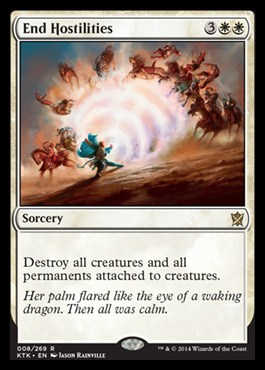
End Hostilities is a board sweeper from the lineage of Wrath of God. The best sweepers have an ability relevant to its context, such as Hallowed Burial dealing with persist, or End Hostilities dealing with bestow, which was a major part of Theros block.
Most importantly, End Hostilities becomes the only unconditional board sweeper in a Standard format that would otherwise rely on Anger of the Gods and Drown in Sorrow. It’s indisputable that white now has the most powerful and far-reaching sweeper in Standard. End Hostilities is a huge tool for white-based control decks, and and I expect it to have a major impact on Standard until it rotates.
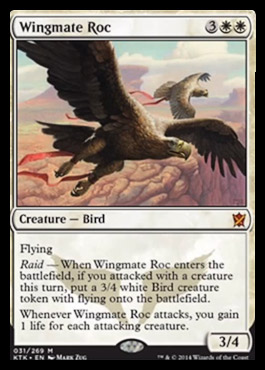
This card screams value. This card will be ideal at the top of an aggressive curve. In a deck with plenty of cheap ways to trigger raid, Wingmate Roc is comparable to a cheaper Broodmate Dragon. Putting two creatures into play for the price of one is card advantage and massive tempo, and I expect this card to bury opponents all Standard season.
The bodies are also very strong for holding back on defense. The trigger of gaining life is not extremely important when analyzing the card, but in specific game situations it will be invaluable. It's strong because it allows its controller to switch to an aggressive stance and all the while gain valuable life points, which makes Wingmate Roc a very difficult card to race.
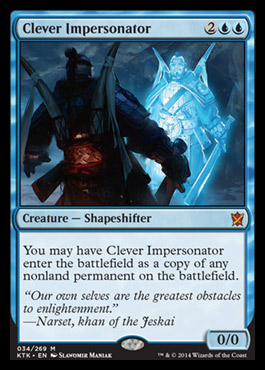
Clone-style cards are as only as good as the cards they can copy. Clever Impersonator goes beyond creatures, and even beyond the artifacts of Phyrexian Metamorph, to include enchantments and planeswalkers.
Planeswalkers. Theros block was dominated by planeswalkers including Elspeth, Sun's Champion, Ashiok, Nightmare Weaver, Xenagos, the Reveler and Kiora, the Crashing Wave. These planeswalkers will all be a major part of the new Standard, as will Nissa, Worldwaker and the newly spoiled Sarkhan, the Dragonspeaker.
Clever Impersonator copies all of these planeswalkers, regardless of the controller. I also see it doing work against the cycle of Ascendancy enchantments, like Temur Ascendancy and Mardu Ascendancy.
Clever Impersonator will be great for copying powerful opposing threats and for creating redundancies within one’s own deck. It will be best of all when copying cards that cost more mana, which leads to a tempo gain.
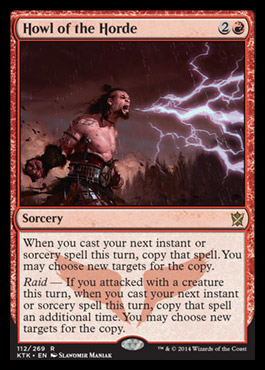
It took me some time to wrap my head around this card, and once I did I saw something quite powerful. Typically these sort of effects just copy a spell, which provides some redundancy, and at best it generates some tempo through mana efficiency when copying a more expensive spell. The cost, of course, is the conditional nature which leads to a lack of consistency.
At worst, Howl of the Horde is a weak Fork. At best, with raid triggered, it’s a double-Fork, and thus, a source of card advantage that also carries the potential for generating massive tempo. It creates two extra spells for the price of copying one, which equates to drawing a spell and playing it for free. Red card advantage is nothing to take lightly, especially considering this card will most likely be copying burn spells. In a deck based around the Philosophy of Fire, Howl of the Horde is a unique and powerful option.
Howl of the Horde gets particularly spicy when combined with...another Howl of the Horde. Copying a Fork doesn’t get anyone anywhere, but copying a double-Fork gets out of hand. As it plays out, a raid-triggered Howl of the Horde followed by another Howl of the Horde, which is necessarily raid-triggered, equals a total Forking power of six extra copies, which added to the original spells comes out to a 7x multiplier on the original.
Howl of the Horde + Howl of the Horde + Lightning Strike = Blackjack.
Howl of the Horde is quite nice with any burn spell, including the M15-reprinted Lightning Strike. But I am most excited about its synergies with Stoke the Flames.
The big condition on Howl of the Horde is raid, which requires a healthy number of creatures to be triggered reliably--which is at odds with pairing the card with lots of spells to prevent it being a dead draw. Stoke the Flames is also at its best with lots of creatures, so I imagine these two cards will be going hand-in-hand all season long.
Stoke the Flames is also ideal because it can be cast cheaply, even for free, which helps overcome the three-mana restriction imposed Howl of the Horde. A deck that can strike a balance between burn spells and creatures for raid will take full advantage of Howl of the Horde.
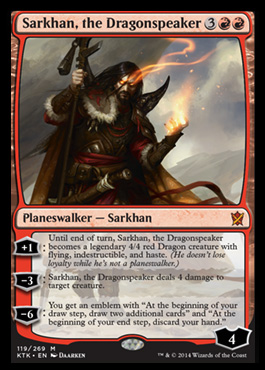
Sarkhan, the Dragonspeaker may be best analyzed not as a planeswalker but as something else entirely. It’s essentially a hybrid of a removal spell and a dragon, with a little upside in its -3 ability.
The latter will kill most creatures below Sarkhan on the curve, including Courser of Kruphix. This gives him some ability to protect himself, but most importantly a way to generate tempo immediately. This ability is rare on a planeswalker, and it reminds me a bit of the -1 on Jace, the Mind Sculptor, but more so the -2 conditional removal ability of Gideon Jura.
It will demand an answer, and it if it can survive for a turn or more it will quickly win the game with its ability to attack. The ability to turn into a 4/4 hasted flyer makes it a strong clock and a card that’s never truly dead. The ultimate ability comes quickly, and while it does not impact the board, it generates massive card advantage that a red deck with burn and cheap creatures will convert to a win.
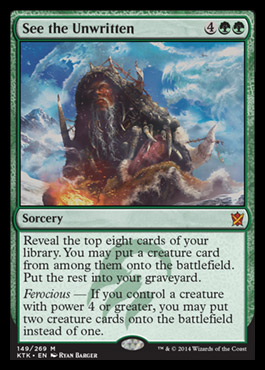
This card reminds me of Summoning Trap. While it does not come with built-in counterspell hate, it’s much better at doing what it does best.
For starters, See the Unwritten digs down eight cards compared to the seven of Summoning Trap. This gives it more digging power, which leads to greater options, and makes See the Unrritten a more consistent card. The biggest downside to this sort of card is that it sometimes will miss the mark, and See the Unwritten will miss less often.
With the ferocious trigger, See the Unwritten finds two creatures for the price of one, which makes it very, very powerful. In games where ferocious triggers, this card carries the potential for completely taking over a game.
It’s the sort of ability that will snowball a small lead into a smashing victory, so it’s the sort of card worth building around. A deck abusing See the Unwritten will already want to play large creatures to cheat into play, so its a natural pairing with ferocious.
The spoilers will continue until the prerelease two weekends from now. The fetchlands and flashy gold cards will get the most of the attention from the masses, but the smart money is on the simple staples that will be relevant for years to come.






I think Howl into Howl is only 4x, not 6x. Howl1 copies Howl2 twice, but Howl2a does not affect Howl2b since Howl2b isn’t “cast”.
Casting it twice actually means seven times the same spell. You get two copies for each of the Raid Forks, so the recursive formula is a(n+1) = 2*a(n) +1.
one casting: 2*1+1 = 3 (use as n for next stage of recursive formula)
two castings: 2*3+1 = 7
three castings: 2*7+1 = 15.
I took that equation from a forum. Before writing the article I talked to multiple judges and they explained the 6 extra copies.
Summoning Trap digs down seven cards, not six, so I still feel summoning trap is much better. This card might see play if we get some nice creatures though.
fixed thanks. As far as eternal formats like Modern are concerned I have to agree with you that Summoning Trap is probably the better card overall. Some of the real value in See the Unwritten is that it creates redundancy in strategy and might allow for a deck built around both cards.
I really like the Roc but, like Broodmate to Baneslayer, Stormbreath just stands in the way. Although, back then the Broodmate player would board in Combust. I wonder what the Roc player will board in against Stormbreath. I guess it depends on the wedge.